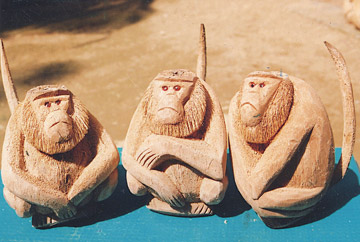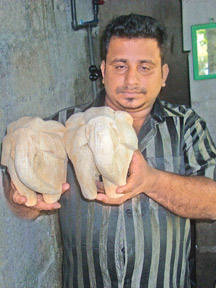|
Coconut creations:
Sculptors seek permanent sales centre
|

Figures of monkeys and apes, carved from coconuts.
|
Have you heard about craftsmen who are engaged in sculpturing small
scale portraits out of raw coconuts? They not only make portraits of
people, but also figures of animals out of coconuts. I am sure only few
would have seen our craftsmen sculpturing portraits and figures from
coconuts. These items are called coconut creations.
Making portraits and figures out of coconuts is not an easy task. It
is a time consuming job. Sometimes, it takes more than three hours to
carve a single portrait.
In the ancient times, village people made portraits from coconuts as
a hobby. But, during the colonial period, it became a self-employment
project as there was a great demand for coconut creations from British
nationals. They not only admired the portraits and figures made out of
coconuts, but also visited rural villages to have the glimpse of the
art.
Making portraits and figures from coconuts has now become an
industry. The industry has a history of over 1000 years. The history
reveals that even before the colonial period, village craftsmen were
engaged in making sculptures out of coconuts. The book titled
`Sculptures of Sri Lanka’ has published a comprehensive report on
coconut creations.
The coconut carvings could be designed only from well matured large
size coconuts. Craftsmen need tool kits which include pointed knives and
forceps to carve the nut into various shapes. After finishing the
portrait, the coconut water and the kernel is removed very carefully by
piercing a small hole. The kernel is chopped into tiny pieces and
removed. If the kernel is thick, it takes even hours to remove from
inside.
The Sunday Observer last week visited a remote village of
Aluthambalama at Ihala Kosgama to meet craftsmen who are engaged in
making small scale portraits and figures out of coconuts. The village is
located a few kilometres away from Avissawella.
My visit to this rural village for the first time with a cameraman
and a former village Grama Seva Niladari named David Appuhamy was very
enjoyable, but tiring. David Appuhamy was in his late seventies, but
still active. He took us to the interior of the village to meet both men
and women who were engaged in the industry.
The village gravel roads were not in a perfect condition, even a
trishaw was unable to ply due to large pot holes all over the road. The
pot holes were full of muddy water. The leeches on small tree tops gave
us little inconvenience when walking on foot paths.
From the ancient days, the village has been very popular for making
coconut sculptures. Even on our way some villagers inquired whether we
came for a media coverage as they were used to meet media groups who
often visit the village to see the art of making portraits out of
coconuts.
 |
 |
|
Village craftsmen with
their products. |
A middle-aged villager, 63-year-old P. Saranapala said around one or
two television programs on coconut portraits and craftsmen engaged in
the industry are shown on television every month and it encourages
villagers.
We had come to know that the livelihood of over 27 families in
Aluthambalama village is making creations from coconuts. Although these
families are leading a very happy life with their aged-old industry,
they complain that they have no proper place to exhibit and sell their
products.
A long standing industrialist, 31-year old Priyantha Premakumara of
Ihala Kosgama said he started the portrait making industry at the age of
15 and manufacturing mainly the figures of animals such as elephants,
tuskers, baby elephants, monkeys, chimpanzees, rabbits, tortoises, frogs
and lions.
He said he sells his products in tourist hotels and also to tea
export companies. The tea companies insert a small quantity of 100 gram
blended high quality Lankan tea inside the belly of elephants and other
animals. They export them to countries such as England, Japan,
Australia, Germany, France and USA.
Priyantha said he earns a sufficient income for his creations from
tea companies and tourist hotels, but many craftsmen in the
Aluthambalama village are not in a position to earn enough money for
their products.
He proposed, authorities including politicians in the area to
establish a sales zone with at least 30 stalls by the side of the
Colombo - Ratnapura Main Road at Ihala Kosgama, so that craftsmen are
enable to sell their products under one roof.
Priyantha also thanked area parliamentarians including Ministers
Geethanjana Gunewardena and Dinesh Gunawardana for providing these
families with tool kits to manufacture portraits.
He said if a sales zone is established at Ihala Kosgama under the
supervision of the Divisional Secretariat, even hundreds of tourists who
travel to Ratnapura, Nuwara Eliya and Bandarawela everyday could stop
and purchase products at reasonable prices.
Priyantha said a carved monkey is sold by them at Rs. 200.00 to some
tourist hotels and the same product is sold at Rs. 800 to foreigners.
“This could be stopped if a sales zone is established in the area as
tourists could visit the place to purchase products.”
Priyantha also said President Mahinda Rajapaksa has a vision to
uplift rural villages by helping craftsmen to develop their traditional
industries and said he would appreciate if the President visits the
Aluthambalama village, so that he himself could be able to see the
situation of craftsmen who make various items out of coconut.
A 48-year-old portrait manufacturer, Ranjith Danapala said he has
been in the industry for the past 15 years and lamented that no progress
in the industry without the support of officials.
“On behalf of craftsmen in the village, I would appeal authorities to
make arrangements to establish a sales village in the Aluthambalama
area, so that not only local buyers, but also foreigners could visit the
village and also to see the art of manufacturing products.”
A young craftsman, Danushka Sanjeewa said people have enough raw
materials to produce coconut creations but due to lack of sales centres,
they cannot sell their products.
He proposed the Sri Lanka Tourism to arrange tour guides to bring
tourists to their village at Ihala Kosgama, so that they could sell
their products at reasonable prices.
Another craftsman Athula Priya Shantha said although they have been
asking authorities to establish a sales zone in their area during the
past 25 years, they only promised to do so, but so far not done.
He therefore urged authorities to establish the proposed sales zone
to enable them to sell products easily.
A craftsman Gemunu Silva said he has made the portrait of President
Mahinda Rajapaksa out of a coconut and wishes to present it to the
President.
He therefore requested the President to visit the Aluthambalama
village at least while on his official visit in the Sabaragamuwa
Province during this election period. A longstanding craftsman, Ajith
Wijesinghe said he has been engaged in the industry for the past four
decades and lamented that there is no proper market to sell the
products.
He therefore requested authorities to help the craftsmen to establish
a proper place to sell the products.
The Sunday Observer also got a rare opportunity to forward the
grievances of craftsmen to the Secretary of Western Province Minister of
Co-operatives Dumindu Kodikara.
According to Kodikara, his Ministry has already done a feasibility
report on a suitable place to establish a sales zone at Aluthambalama.
He assured that a co-operative sales zone will be constructed in the
area as early as possible, so that all craftsmen could do their sales
under one roof.
AK
|


